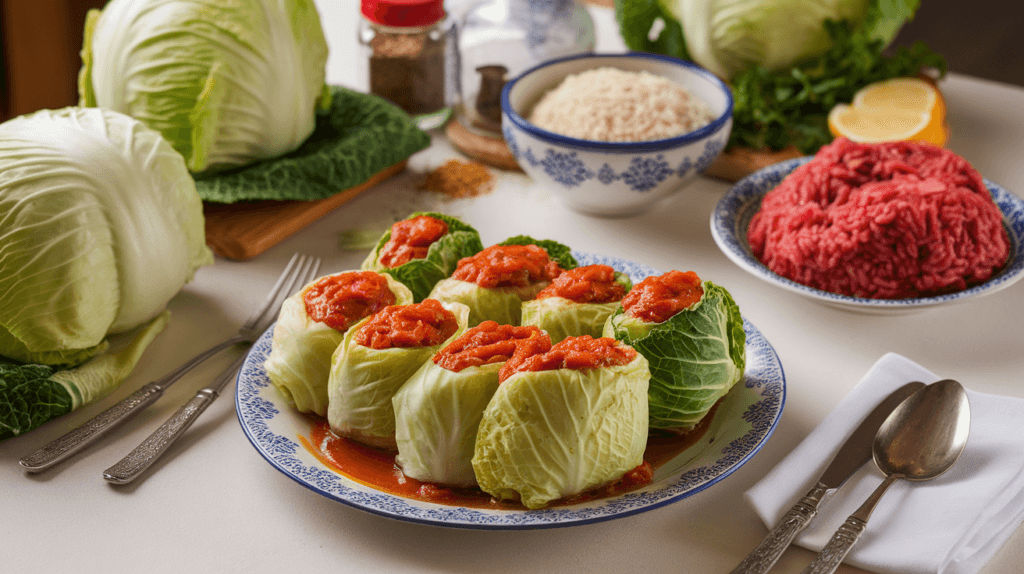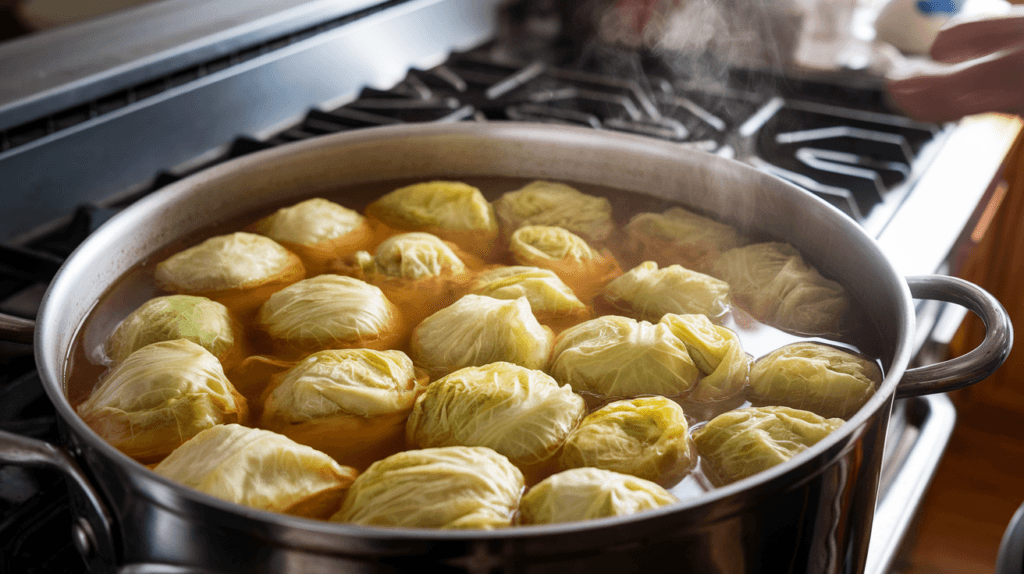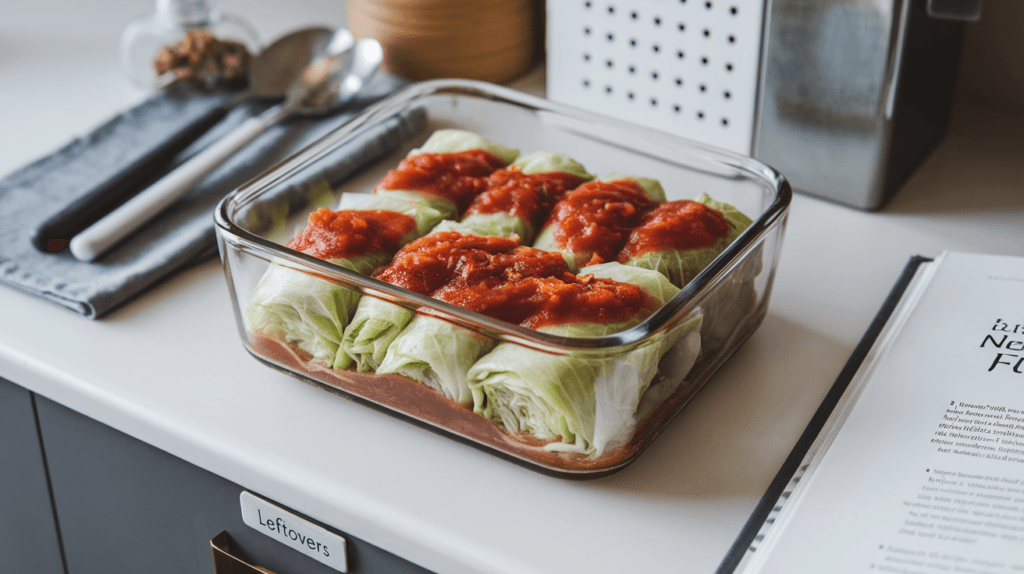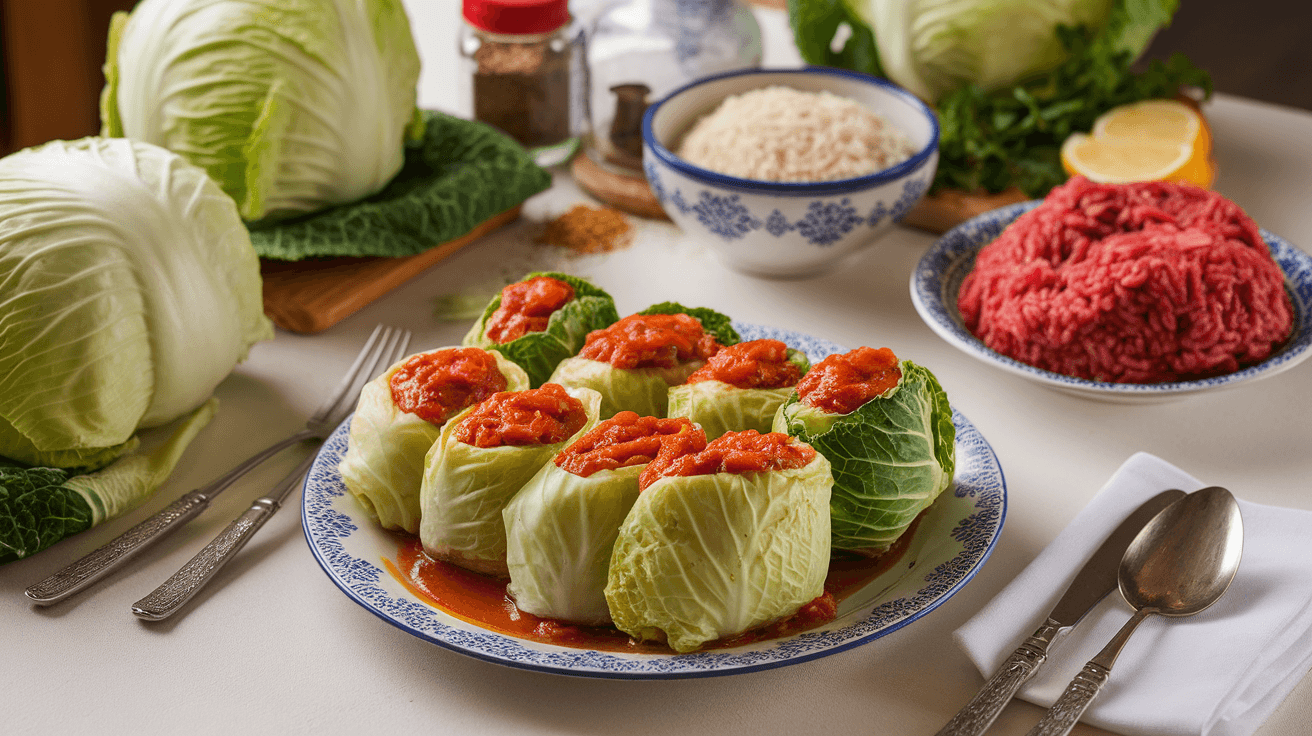Introduction
Cabbage rolls are a beloved dish in many cuisines, offering a perfect balance of flavors and textures. However, a common issue faced by many home cooks is ending up with hard or tough meat inside their cabbage rolls. This can be frustrating, especially when you’ve put in the effort to create this comforting dish.
In this article, we’ll explore the possible reasons why the meat in your cabbage rolls turns out hard and provide detailed solutions to ensure your cabbage rolls come out tender and delicious every time.

Common Reasons for Tough Meat in Cabbage Rolls
Understanding why the meat in your cabbage rolls turns out hard is the first step toward solving the problem. Here are some common culprits:
1. Why Lean Meat Leads to Tough or Hard Cabbage Roll Filling
Lean meats, such as ground turkey or extra-lean ground beef, lack the fat content needed to keep the filling moist and tender. Fat plays a crucial role in preventing the meat from drying out during cooking, and its absence can result in tough meat.
2. How Overmixing Can Cause Hard Meat in Your Cabbage Rolls
While mixing the filling ingredients together, it’s easy to overwork the meat mixture. Overmixing can break down the meat’s fibers, leading to a dense and chewy texture once cooked.
3. Why High Temperatures Result in Hard Cabbage Roll Meat

High cooking temperatures can cause the meat to toughen quickly. Whether you’re boiling, baking, or simmering, cooking too fast or at excessive heat can leave the meat undercooked on the inside and tough on the outside.
4. Insufficient Moisture
If there isn’t enough liquid or broth in the cooking environment, the meat can dry out. Cabbage rolls need to be cooked in a well-seasoned, moisture-rich environment to maintain a tender texture.
5. Incorrect Cooking Time
Both undercooking and overcooking can make the meat hard. Undercooked meat won’t have had enough time to tenderize, while overcooking can dehydrate the filling.
6. Incorrect Meat-to-Rice Ratio
If there’s too much meat in proportion to rice or other fillers, the filling may become dense and less forgiving during cooking. A balanced ratio ensures proper texture and flavor.
Choosing the Best Meat for Tender Cabbage Roll Filling
The type and quality of meat you use for your cabbage rolls significantly impact their final texture. Selecting the right meat ensures that your filling remains tender and flavorful. Below are some tips to guide your choice:
1. Opt for Meat with Higher Fat Content
Fat is your friend when making cabbage rolls. Choose ground beef with at least 15-20% fat content or consider mixing pork and beef for a balanced flavor and texture. Pork adds richness and keeps the filling moist.
2. Avoid Overly Lean Options
As tempting as it may be to use lean options like ground turkey or chicken, they are prone to dryness. If you prefer a leaner protein, consider adding a small amount of oil or mixing in finely chopped vegetables like onions or carrots for extra moisture.
3. Experiment with Meat Combinations
Blending different meats can elevate the taste and texture of your cabbage rolls. For instance, mixing beef, pork, and even lamb can provide a unique flavor profile while ensuring tenderness. Each meat contributes distinct characteristics to the filling.
4. Best Fillers to Prevent Chewy Cabbage Roll Meat
A well-balanced meat-to-filler ratio is key. Rice, breadcrumbs, or cooked quinoa can act as fillers that help retain moisture and lighten the density of the meat filling. This prevents the filling from becoming overly compact.
5. Use Freshly Ground Meat
If possible, use freshly ground meat or grind your own. Pre-packaged ground meat may contain additives or be over-processed, which can affect the texture and flavor. Freshly ground meat ensures better control over the quality of your filling.
6. Season Generously
The right combination of seasonings, such as garlic, onion, salt, pepper, and herbs, not only enhances flavor but also helps break down the meat’s structure slightly, contributing to tenderness during cooking.
Cooking Methods to Prevent Hard Meat in Cabbage Rolls
The way you cook your cabbage rolls plays a pivotal role in determining the texture of the meat filling. Proper techniques and adjustments can ensure that your cabbage rolls turn out tender and delicious every time.
1. Simmer Instead of Boil
Cooking cabbage rolls in a pot with a simmering liquid rather than boiling them ensures gentle heat distribution. Boiling can cause the outer layers to cook too quickly while leaving the inside tough. A low and slow simmer is ideal for tender meat.
2. Opt for Oven Baking
One of the best methods for achieving perfectly cooked cabbage rolls is baking them in the oven. Cover the rolls with a flavorful tomato sauce or broth, seal the baking dish tightly with aluminum foil, and bake at 350°F (175°C) for 1.5 to 2 hours. This method ensures even cooking and helps the filling stay moist.
3. Use a Slow Cooker
Slow cookers are an excellent choice for tender cabbage rolls. Place the rolls in the cooker, add sauce or broth, and cook on low for 6-8 hours. The slow cooking process allows the flavors to meld while keeping the meat tender and juicy.
4. Avoid Overcooking
While slow cooking is beneficial, leaving the rolls on the heat for too long can cause the meat to lose its moisture and become dry. Follow recommended cooking times to prevent overcooking.
5. Layer for Better Heat Distribution
When preparing cabbage rolls, avoid overcrowding the pot or dish. Overlapping rolls can result in uneven cooking. Instead, layer the rolls with a bit of sauce or broth in between to ensure consistent heat distribution.
6. How Proper Liquid Levels Help Tenderize Cabbage Roll Meat
Ensure that your cooking liquid covers at least two-thirds of the rolls. This helps to steam the rolls and keeps the filling moist. Use a mixture of tomato sauce, broth, and seasonings for maximum flavor.
7. Rest Before Serving
After cooking, let the cabbage rolls rest for about 10-15 minutes before serving. This allows the juices to redistribute throughout the filling, enhancing both flavor and tenderness.
Seasoning and Moisture Tips for Soft Cabbage Roll Meat
The right seasoning and moisture levels in your cabbage rolls are crucial to achieving a tender, flavorful filling. Here’s how to strike the perfect balance:
1. Moisture-Rich Ingredients to Prevent Hard Cabbage Roll Filling
Adding moisture-rich ingredients to your meat mixture can help prevent dryness. Finely chopped onions, grated zucchini, or even a small amount of sour cream can infuse moisture into the filling while adding subtle flavors.
2. How Sauce in the Filling Helps Prevent Tough Meat in Cabbage Rolls
Mixing a small amount of tomato sauce or broth directly into the meat mixture before rolling the cabbage leaves can prevent the meat from drying out during cooking. This step also enhances the overall flavor of the dish.
3. Balancing Salt and Spices to Avoid Hard Meat in Cabbage Rolls
Seasoning plays a key role in breaking down the meat proteins slightly, which contributes to tenderness. Use a balanced mix of salt, pepper, garlic powder, onion powder, paprika, and herbs like dill or parsley for flavor without overwhelming the meat.
4. Why Excessive Bread Crumbs Can Cause Tough Meat in Cabbage Rolls
While breadcrumbs can help bind the filling, using too much can absorb the natural juices, leading to a dry texture. Stick to a small amount—just enough to hold the mixture together.
5. Cooking Liquid: A Key to Soft and Juicy Cabbage Roll Meat
When assembling your cabbage rolls in the pot or baking dish, pour enough sauce or broth to create a moist cooking environment. The liquid should cover about two-thirds of the rolls to ensure steaming and braising during cooking.
6. Consider Adding a Lid
Whether baking or simmering, covering the pot or dish traps steam, which helps keep the cabbage rolls moist. If baking, use foil or a tightly fitting lid to prevent liquid evaporation.
7. Adjust Liquid Consistency
The sauce or broth should have a slightly thickened consistency to coat the cabbage rolls without being too watery. This ensures the flavor adheres to the rolls and enhances their tenderness.
8. Test the Filling
Before rolling your cabbage leaves, cook a small portion of the filling in a skillet to test the seasoning and texture. This allows you to adjust the seasoning or moisture level as needed before assembling the rolls.
Tips to Avoid Tough or Dry Cabbage Roll Meat
To consistently create tender, flavorful cabbage rolls, follow these actionable tips:
1. Prepare the Cabbage Properly
Blanch the cabbage leaves in boiling water for a few minutes before rolling. Softened leaves are easier to handle and won’t tear as easily. This step also ensures the cabbage cooks evenly with the filling.
2. Don’t Overstuff the Rolls
Use a moderate amount of filling to prevent the cabbage rolls from bursting open during cooking. Smaller, evenly packed rolls ensure thorough cooking and better texture.
3. Use a Flavorful Base
Line the bottom of your pot or baking dish with a layer of cabbage leaves or sliced vegetables like carrots and onions. This prevents sticking and adds extra flavor to the dish.
4. Check for Doneness
To ensure the filling is fully cooked, insert a fork or knife into one of the rolls and check for tenderness. The internal temperature of the meat filling should reach 160°F (71°C).
5. Experiment with Variations
For a unique twist, try incorporating different herbs and spices, or experiment with alternative fillings like quinoa or lentils for a vegetarian option. These variations can add new dimensions of flavor and texture to your cabbage rolls.
6. Plan for Leftovers

Cabbage rolls often taste better the next day as the flavors meld. Store leftovers in an airtight container in the refrigerator for up to 3 days or freeze them for longer storage.
Common Mistakes to Avoid
Even experienced cooks can run into trouble when making cabbage rolls. Avoid these common mistakes to ensure your rolls turn out tender and delicious:
1. Not Softening the Cabbage Leaves
Skipping the step of blanching or steaming the cabbage leaves can result in tough rolls that are difficult to roll and chew. Always soften the leaves to make them pliable and easy to work with.
2. Overstuffing the Rolls
Filling the cabbage leaves with too much meat mixture can lead to uneven cooking and rolls that split open during cooking. Use a moderate amount of filling to ensure the rolls cook evenly and hold their shape.
3. Using Insufficient Liquid
Dry cooking environments can cause the rolls to dry out. Always use enough sauce or broth to cover at least two-thirds of the rolls, ensuring they remain moist throughout the cooking process.
4. Ignoring Seasoning in the Sauce
The sauce plays a crucial role in flavoring the cabbage rolls. An under-seasoned sauce can make the entire dish taste bland. Be generous with herbs, spices, and seasonings to enhance the overall flavor.
5. Rushing the Cooking Process
Cooking cabbage rolls at high heat or for a short duration can result in unevenly cooked meat and tough cabbage. Patience is key; opt for slow, gentle cooking methods like simmering or baking.
6. Forgetting to Taste Test
Not tasting the filling mixture before rolling the cabbage can lead to flavor imbalances. Cook a small portion of the filling in a skillet to test for seasoning and make adjustments as needed.
7. Overcrowding the Cooking Dish
Overcrowding can cause uneven cooking and make it difficult for the sauce to circulate properly. Use a large enough pot or dish to give each roll enough space to cook evenly.
By keeping these common mistakes in mind, you can avoid unnecessary pitfalls and ensure your cabbage rolls turn out tender, juicy, and full of flavor every time.
FAQ
1. Why is my cabbage roll filling dense?
Dense filling can result from overmixing the meat mixture or using a high meat-to-rice ratio. Mix gently and ensure balanced proportions of ingredients.
2. Can I use raw rice in the filling?
Yes, but ensure the cabbage rolls are cooked long enough to allow the rice to soften. Par-cooking the rice before mixing is recommended for a more consistent texture.
3. How can I prevent my cabbage rolls from falling apart?
Blanch the cabbage leaves properly, avoid overstuffing, and roll them tightly. Use toothpicks or kitchen twine if needed to secure the rolls during cooking.
4. Should I cook the filling before rolling?
No, the filling typically cooks inside the cabbage rolls. Cooking it beforehand may result in overcooked filling by the time the cabbage is tender.
5. What’s the best sauce for cabbage rolls?
A tomato-based sauce with a touch of sweetness and acidity works best. You can enhance it with garlic, herbs, or a splash of vinegar for added depth of flavor.
6. Can I make cabbage rolls ahead of time?
Absolutely! Assemble the rolls and refrigerate them overnight before cooking. This allows the flavors to meld, making the dish even more delicious when cooked.
Conclusion
Cooking perfect cabbage rolls doesn’t have to be a challenge. By understanding the reasons behind hard meat and applying the tips shared in this article, you can create soft, flavorful cabbage rolls every time. From choosing the right meat to mastering the cooking process, these steps will elevate your cabbage rolls to a whole new level.
So, the next time you prepare this comforting dish, keep these techniques in mind. With a little patience and practice, you’ll impress your family and friends with perfectly tender and delicious cabbage rolls!

